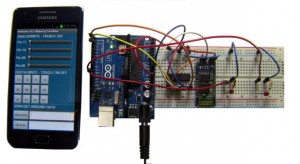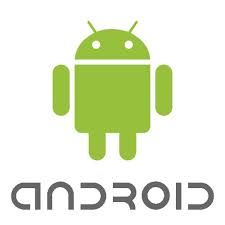We had a few photos taken at Gasworks park to show off some of the new wearable LED projects I have been working on. This is basically what we will be wearing out for Halloween on Friday.
Continue reading Richard and Emily’s Halloween
Tag: Arduino
The Sparkling Chameleon Fur Wrap
This is a variant of the Adafruit Chameleon Scarf that I recently made. I made the color fade and randomly twinkle rather than stay on all the time. I also added a button to restart the color sample sequence as well. To include some motion feedback, I used a Fast Vibration Sensor Switch to increase the number of pixels that go bright when it is triggered.
ArduDroid & HC-05 Bluetooth
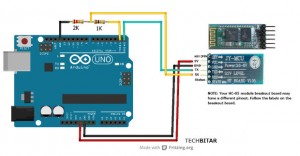
REQUIREMENTS
- Breadboard wiring and electronics skills.
- Arduno Uno.
- HC-05 Bluetooth serial module.
INTRODUCTION
ArduDroid (formerly Andruino) is a simple tool to help you control your Arduino (or clone) from your Android phone. It’s both an Android app and an Arduino program. ArduDroid has a simple Android user interface to 1) control Arduino’s digital and PWM pins 2) send text commands to Arduino 3) and receive data from Arduino over Bluetooth serial using the ever popular and really cheap (less than $10 from ebay) HC-05 Bluetooth over serial module. This app has been tested and designed for the HC-05 Serial Bluetooth module. Other Bluetooth modules may or may not work. Please see comments section for users who tried other Bluetooth modules with this app.
INSTALL FROM GOOGLE PLAY
https://play.google.com/store/apps/details?id=com.techbitar.android.Andruino
ArduDroid should work with other Bluetooth modules with some tweaking but I have only tested it with the HC-05. This is an alpha version that’s running fine on my Samsung Galaxy S2 Plus. Please share your experience running ArduDroid on your phone. Also, while I used Arduino Uno in this prototype, feel free to experiment with other models of Arduino. Please share your experience to help me improve this app.
I have published a guide before on building and programming a circuit with the HC-05 Bluetooth module and Arduino but I will briefly describe again in this guide how to wire the circuit using a breadboard and jumper wires.
ArduDroid is an app that evolved during one of my development projects. Special thanks to engineer Jafar Quttaineh for testing the app and for his invaluable input.
Step 1: How to use ArduDroid
You can use ArduDroid to send commands to Arduino to control a relay to turn electric gadgets on/off, control a robot servo, increase/decrease speed of a motor and reverse direction, dim a light, speed up a fan, and so on. Furthermore, you can read Arduino pins and sensors then transmit the data back to your android phone.
Step 2: ArduDroid components & downloads
1) Install ArduDroid from Google Play:
For previous version downlowded from my website, this is the certificate fingerprints:
MD5 : BA:80:C2:6A:68:31:8F:21:D6:FC:08:8E:09:D8:F5:CF
SHA1: 04:EA:2E:47:80:71:BE:D9:D2:ED:86:5F:15:1F:1E:9E:77:62:DB:85
2) Download the Arduino program: ardudroid.ino (requires Arduino IDE 1.05 or later)
HARDWARE
- Android device running version 2.3.3 or higher with Bluetooth.
- Arduino Uno or clone.
- CD4050 level shifter IC or 2K Ohms & 1K Ohms resistors as voltage dividers.
- HC-05 Bluetooth module. Other Bluetooth over serial modules should work with some modifications.
- Breadboard & jumper wires.
- Power source.
Step 3: Wiring the Circuit
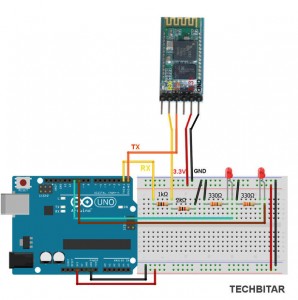
Please note that while my actual prototype as shown in the video and photo uses the CD4050 IC to level shift from 5V to 3.3V, in the wiring diagram I am using a voltage divider because I believe it will be simpler for most people to acquire the resistors than the IC. You only need to drop the Arduino’s TX voltage to 3.3V to match the RX of the HC-05. The Arduino’s RX pin can handle the HC-05 incoming TX signal which is 3.3V.
I used 2K and 1K ohms resistors in my circuit diagram to drop 5V to 3.3V but you can use different resistor values. Google “voltage divider calculator” and use the myriad calculators to determine what other resistor values work best for you.
Step 4: How to modify the ArduDroid companion program

On the Arduino side I have included a skeletal program (ardudroid.ino) that intercepts and processes the ArduDroid commands issued from your Android device. You can update the Arduino code according to your project needs.
ArduDroid is an Android app that sends/receives data from Arduino with the help of an Arduino sketch named ardudroid.ino In this sketch, there are four code blocks supporting the four key functions of ArduDroid. You can modify these code blocks to suit your requirements.
The blocks are labeled according to their functions in a comment line at the start of each code block. I inserted a comment “// add your code here” to help you find and place your code, but you can decide how you wish to modify the functional code blocks.
Step 5: Control analogWrite pins
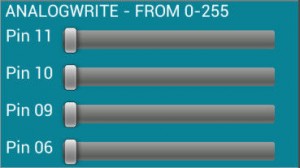 This is the code block that receives the PWM value from 0 to 255 that you send from Android to control the PWM designated Arduino Uno pins 11,9,10,5,4,3. You can add code to control a motor for a robot or fan, for example, to speed it up or slow it down. Or you can send a command to dim a light.
This is the code block that receives the PWM value from 0 to 255 that you send from Android to control the PWM designated Arduino Uno pins 11,9,10,5,4,3. You can add code to control a motor for a robot or fan, for example, to speed it up or slow it down. Or you can send a command to dim a light.
// 3) GET analogWrite DATA FROM ARDUDROID
if (ard_command == CMD_ANALOGWRITE) {
analogWrite( pin_num, pin_value );
// add your code here
return; // Done. return to loop();
}
Step 6: Control digitalWrite pins
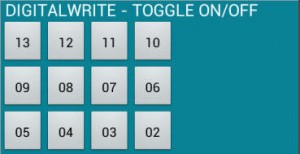 This is the code block that receives from Android the pin number and the ON/OFF (HIGH/LOW) value to toggle the corresponding pin. You can turn a relay on /off to switch an electrical device. Please note that this code block calls a function set_digitalwrite() which has a Switch/Case structure to give you room to write code to act on each pin separately.
This is the code block that receives from Android the pin number and the ON/OFF (HIGH/LOW) value to toggle the corresponding pin. You can turn a relay on /off to switch an electrical device. Please note that this code block calls a function set_digitalwrite() which has a Switch/Case structure to give you room to write code to act on each pin separately.
// 2) GET digitalWrite DATA FROM ARDUDROID
if (ard_command == CMD_DIGITALWRITE){
if (pin_value == PIN_LOW) pin_value = LOW;
else if (pin_value == PIN_HIGH) pin_value = HIGH;
else return; // error in pin value. return.
set_digitalwrite( pin_num, pin_value); // call function to process digital pin#
return; // return from start of loop()
}
// 2a) select the requested pin# for DigitalWrite action
void set_digitalwrite(int pin_num, int pin_value)
{
switch (pin_num) {
case 13:
pinMode(13, OUTPUT);
digitalWrite(13, pin_value);
// add your code here
break;
. . .
. . .
. . .
case 2: pinMode(2, OUTPUT);
digitalWrite(2, pin_value);
// add your code here
break;
// default:
// if nothing else matches, do the default
// default is optional
} }
I have excluded pin 0 and pin 1 because they are used for Arduino Uno serial communication by default. I might enable those two pins in future releases of the app and leave it up to the user to determine which pins will be used for the Arduino serial communications.
Step 7: Send text/command from Android to Arduino
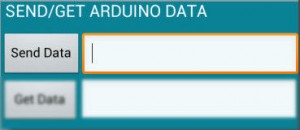 This is the code block that handles the text you type in the field next to Send Data button. For example, you can send a password to activate/login into a system. Or you can send text to an LCD connected to Arduino to display something.
This is the code block that handles the text you type in the field next to Send Data button. For example, you can send a password to activate/login into a system. Or you can send text to an LCD connected to Arduino to display something.
// 1) GET TEXT COMMAND FROM ARDUDROID
if (ard_command == CMD_TEXT){
inText =""; //clears variable for new input
while (Serial.available()) {
char c = Serial.read(); //gets one byte from serial buffer
delay(5);
if (c == END_CMD_CHAR) { // if we the complete string has been read
// add your code here
break;
}
else {
if (c != DIV_CMD_CHAR) {
inText += c;
delay(5);
} } } }
Step 8: Get text/command from Arduino
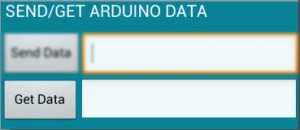 This code block sends anything you want from Arduino to your Android. In my sample code below, I send the value of analog pin 0 whenever I press the Get Data button. Since analog pin is not connected to anything in the demo video, I was getting ambient noise values. Please note that there is no error detection/correction in my code block. If accuracy is critical to your app, make sure you add error detection such as visual markers to enclose the data being sent or a checksum.
This code block sends anything you want from Arduino to your Android. In my sample code below, I send the value of analog pin 0 whenever I press the Get Data button. Since analog pin is not connected to anything in the demo video, I was getting ambient noise values. Please note that there is no error detection/correction in my code block. If accuracy is critical to your app, make sure you add error detection such as visual markers to enclose the data being sent or a checksum.
// 4) SEND DATA TO ARDUDROID
if (ard_command == CMD_READ_ARDUDROID) {
// char send_to_android[] = "Place your text here." ;
// Serial.println(send_to_android); // Example: Sending text
Serial.print(" Analog 0 = ");
Serial.println(analogRead(A0)); // Example: Read and send Analog pin value to Arduino
return; // Done. return to loop();
}}
Step 9: Things to consider
There are a quite a few solutions to enable Android-Arduino integration. The more expensive and complex ones involve specialized and costly hardware such as Google’s ADK, but by far the cheapest and in my opinion the simplest is the Bluetooth integration using the HC-05 transceiver. I expect WiFi to eventually replace Bluetooth with the help of WiFi Direct (point to point WiFi communications without a router) but his is a couple of years down the road.
As for Bluetooth-based solution for Android to Arduino communication, you can find a few approaches to pick from depending on your project needs and the degree of abstraction you are looking for. Some approaches use a terminal app on the Android such as Blueterm to send and receive raw text data from Arduino over Bluetooth SPP. Others solutions employ a comprehensive library such as Amarino. My ArduDroid sits in the middle.
Notes on support and updates
I will do my best to support ArduDroid and I am hoping that those of you who find this tool useful to share your expertise with other users. Please let me know if you run into any bugs or problems running ArduDroid on your device. Kindly note the device model and OS version as well as other useful info.
Please feel free to leave a comment if you have any technical questions.
LED Matrix Pendant
I made a pendant for my girlfriend as a Halloween present. The animation was changed to an eye that blinks and looks around. I really wanted it not to just loop the same animation so I set out to create a few animations for the pendant to cycle through at random including a few longer blackout periods. I am still rather new to the coding side of this and didn’t understand some of the code, but here is the version I have working as of now. Continue reading LED Matrix Pendant
New budget robot is working.
After working on many designs I have come up with this little guy: Continue reading New budget robot is working.
Basic Robot design.
These are the electronic components necessary to build a basic robot for children that uses two vibration motors to move forward, left, and right. Two digital pins are used to control the vibration motors leaving 3 open GPIO pins. The Photo cell and LED can be used to detect the presence, and close proximity, of another robot. The Micro servo is an optional add on so that a simple claw (http://www.thingiverse.com/thing:18339) can be added. Continue reading Basic Robot design.



